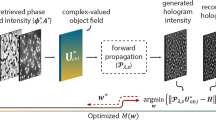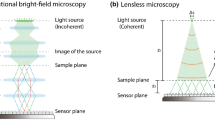Abstract
Optical images are inevitably stained by the multiple aberrations from an optical imaging link itself (OILI, e.g., the camera itself involving an optical system, an electronic system, and a sensor). The development of techniques that enable optical full-link imaging without the OILI aberrations is desirable. In this paper, we demonstrate an aberration-free backward-link imaging method for optical full-link imaging. This method utilizes a batch learning network to reconstruct the invariable point spread function (IPSF) of the imaging processing, which is constant and produced by the design, fabrication, and assembly. The inverted IPSF in conjunction with a digital filter can correct the distorted wavefront aberrations caused by the OILI. This is confirmed experimentally. This method opens the door to aberration-free full-link optical imaging for the involved imaging system applications, such as Coarse Holography Displays.










Similar content being viewed by others
References
Zhang Z (2000) A flexible new technique for camera calibration. IEEE Trans Pattern Anal Mach Intell 22:1330–1334
Pohl C, Van Genderen JL (1998) Review article multisensor image fusion in remote sensing: concepts, methods and applications. Int J Remote Sens 19(5):823–854
Hirano A, Welch R, Lang H (2003) Mapping from ASTER stereo image data: DEM validation and accuracy assessment. ISPRS J Photogramm Remote Sens 57(5):356–370
Li J, Xing F, You Z (2014) Compression of multispectral images with comparatively few bands using posttransform Tucker decomposition. Math Probl Eng 2014:1–17
Freedman WL, Madore BF, Gibson BK, Ferrarese L, Kelson DD, Sakai S, Mould JR, Kennicutt RC Jr., Ford HC, Graham JA, Huchra JP (2001) Final results from the Hubble Space Telescope key project to measure the Hubble constant. Astrophys J 553(1):47
Li J, Smithwick Q, Chu D (2018) Full bandwidth dynamic coarse integral holographic displays with large field of view using a large resonant scanner and a galvanometer scanner. Opt Express 26(13):17459–17476
Li J, Xing F, Chu D, Liu Z (2016) High-accuracy self-calibration for smart, optical orbiting payloads integrated with attitude and position determination. Sensors 16(8):1176
Li J, Xing F, Shrestha PK, Shi F, Liu Z (2019) On-orbit self-focusing using conjugated optical fiber waveguides for space optical cameras. IEEE Geosci Remote Sens Lett 16:1703–1705
Rome M, Fleck HG, Hines DC (1964) The quadrant multiplier phototube, a new star-tracker sensor. Appl Opt 3(6):691–695
Sun T, Xing F, Wang X, Li J, Wei M, You Z (2016) Effective star tracking method based on optical flow analysis for stellar cameras. Appl Opt 55(36):10335–10340
Yadid-Pecht O, Pain B, Staller C, Clark C, Fossum E (1997) CMOS active pixel sensor star tracker with regional electronic shutter. IEEE J Solid-State Circuits 32(2):285–288
Rousseau GLA, Bostel J, Mazari B (2005) Star recognition algorithm for APS star tracker: oriented triangles. IEEE Aerosp Electron Syst Mag 20(2):27–31
Li J, Xing F, Sun T, You Z (2015) Efficient assessment method of on-board modulation transfer function of optical remote sensing sensors. Opt Express 23:6187–6208
Hwang H, Choi YW, Kwak S, Kim M, Park W (2008) MTF assessment of high resolution satellite images using ISO 12233 slanted-edge method. In: Image and signal processing for remote sensing XIV. International Society for Optics and Photonics, vol 7109, p 710905
Oh E, Choi JK (2014) GOCI image enhancement using an MTF compensation technique for coastal water applications. Opt Express 22(22):26908–26918
Lee J, Chun J, Lee D (2012) MTF compensation algorithm based on blind deconvolution for high-resolution remote sensing satellite. In: Visual information processing XXI. International Society for Optics and Photonics, vol 8399, p 83990R
Blonski S, Pagnutti MA, Ryan R, Zanoni V (2002) In-flight edge response measurements for high-spatial-resolution remote sensing systems. In: Earth observing systems VII. International Society for Optics and Photonics, vol 4814, pp 317–327
Guo XJ, Liu XL, Ni C, Liu B, Huang SM, Gu M (2011) Improving image quality of x-ray in-line phase contrast imaging using an image restoration method. Opt Express 19(23):23460–23468
Oh E, Ahn KB, Cho S, Ryu JH (2013) A modulation transfer function compensation for the geostationary ocean color imager (GOCI) based on the wiener filter. J Astron Space Sci 30(4):321–326
Mee JWS (2010) Modulation transfer function compensation through a modified Wiener filter for spatial image quality improvement. Sel Top Power Syst Remote Sens, 177–182
Kundur D, Hatzinakos D (1996) Blind image deconvolution. IEEE Signal Process Mag 13(3):43–64
Chan TF, Wong CK (1998) Total variation blind deconvolution. IEEE Trans Image Process 7(3):370–375
Shalvi O, Weinstein E (1990) New criteria for blind deconvolution of nonminimum phase systems (channels). IEEE Trans Inf Theory 36(2):312–321
Krishnan D, Tay T, Fergus R (2011) Blind deconvolution using a normalized sparsity measure. In: 2011 IEEE conference on computer vision and pattern recognition (CVPR), pp 233–240
Cannon M (1976) Blind deconvolution of spatially invariant image blurs with phase. IEEE Trans Acoust Speech Signal Process 24(1):58–63
Amari SI, Douglas SC, Cichocki A, Yang HH (1997) Multichannel blind deconvolution and equalization using the natural gradient. In: First IEEE signal processing workshop on signal processing advances in wireless communications, pp 101–104
Fish DA, Brinicombe AM, Pike ER, Walker JG (1995) Blind deconvolution by means of the Richardson–Lucy algorithm. JOSA A 12(1):58–65
Levin A, Weiss Y, Durand F, Freeman WT (2011) Efficient marginal likelihood optimization in blind deconvolution. In: 2011 IEEE conference on computer vision and pattern recognition (CVPR), pp 2657–2664
Schulz TJ (1993) Multiframe blind deconvolution of astronomical images. JOSA A 10(5):1064–1073
Holmes TJ (1992) Blind deconvolution of quantum-limited incoherent imagery: maximum-likelihood approach. JOSA A 9(7):1052–1061
Liang J, Williams DR, Miller DT (1997) Supernormal vision and high-resolution retinal imaging through adaptive optics. JOSA A 14(11):2884–2892
Zawadzki RJ, Jones SM, Olivier SS, Zhao M, Bower BA, Izatt JA, Choi S, Laut S, Werner JS (2005) Adaptive-optics optical coherence tomography for high-resolution and high-speed 3D retinal in vivo imaging. Opt Express 13(21):8532–8546
Angel JRP (1994) Ground-based imaging of extrasolar planets using adaptive optics. Nature 368(6468):203
Ragazzoni R, Marchetti E, Valente G (2000) Adaptive-optics corrections available for the whole sky. Nature 403(6765):54
Ji N, Milkie DE, Betzig E (2009) Adaptive optics via pupil segmentation for high-resolution imaging in biological tissues. Nat Methods 7(2):141
Angel JRP, Wizinowich P, Lloyd-Hart M, Sandler D (1990) Adaptive optics for array telescopes using neural-network techniques. Nature 348(6298):221
Macintosh B, Troy M, Doyon R, Graham J, Baker K, Bauman B, Marois C, Palmer D, Phillion D, Poyneer L, Crossfield I (2006) Extreme adaptive optics for the Thirty Meter Telescope. In: Advances in adaptive optics II, international society for optics and photonics, vol 6272, p 62720 N
Roorda A, Romero-Borja F, Donnelly WJ III, Queener H, Hebert TJ, Campbell MC (2002) Adaptive optics scanning laser ophthalmoscopy. Opt Express 10(9):405–412
Sandler DG, Barrett TK, Palmer DA, Fugate RQ, Wild WJ (1991) Use of a neural network to control an adaptive optics system for an astronomical telescope. Nature 351(6324):300
Ohm JR (1994) Three-dimensional subband coding with motion compensation. IEEE Trans Image Process 3(5):559–571
Nakaya Y, Harashima H (1994) Motion compensation based on spatial transformations. IEEE Trans Circuits Syst Video Technol 4(3):339–356
Lareau AG (1993) Electro-optical imaging array with motion compensation. In: International society for optics and photonics in airborne reconnaissance XVII, vol 2023, pp 65–80
Garivait S, Quisefit JP, De Chateaubourg P, Malingre G (1997) Multi-element analysis of plants by WDXRF using the scattered radiation correction method. X-Ray Spectrom Int J 26(5):257–264
Hollands KGT, Crha SJ (1987) An improved model for diffuse radiation: correction for atmospheric back-scattering. Sol Energy 38(4):233–236
Holst GC (2011) Imaging system fundamentals. Opt Eng 50(5):052601
Viallefont-Robinet F, Helder D, Fraisse R, Newbury A, van den Bergh F, Lee D, Saunier S (2018) Comparison of MTF measurements using edge method: towards reference data set. Opt Express 26(26):33625–33648
Viallefont-Robinet F, Léger D (2010) Improvement of the edge method for on-orbit MTF measurement. Opt Express 18(4):3531–3545
Storey JC (2001) Landsat 7 on-orbit modulation transfer function estimation. SPIE 4540:50–62
Goldstein T, Stanley O (2009) The split Bregman method for L1-regularized problems. SIAM J Imaging Sci 2(2):323–343
Goldstein T, Bresson X, Osher S (2010) Geometric applications of the split Bregman method: segmentation and surface reconstruction. J Sci Comput 45(1–3):272–293
Wang Z, Bovik AC, Sheikh HR, Simoncelli EP (2004) Image quality assessment: from error visibility to structural similarity. IEEE Trans Image Process 13(4):600–612
Chen GH, Yang CL, Xie SL (2006) Gradient-based structural similarity for image quality assessment. In: 2006 IEEE international conference on image processing, pp 2929–2932
Mattia C, De Vendictis L (2009) A procedure for high resolution satellite imagery quality assessment. Sensors 9(5):3289–3313
Li J, Liu Z (2019) High-resolution dynamic inversion imaging with motion-aberrations-free using optical flow learning networks. Sci Rep 9(1):1–12
Wu C, Tai XC (2010) Augmented Lagrangian method, dual methods, and split Bregman iteration for ROF, vectorial TV, and high order models. SIAM J Imaging Sci 3(3):300–339
Boyd S, Parikh N, Chu E, Peleato B, Eckstein J (2011) Distributed optimization and statistical learning via the alternating direction method of multipliers. Found Trends® Mach Learn 3(1):1–122
Daneshmand A, Facchinei F, Kungurtsev V, Scutari G (2015) Hybrid random/deterministic parallel algorithms for convex and nonconvex big data optimization. IEEE Trans Signal Process 63(15):3914–3929
Daneshmand A, Facchinei F, Kungurtsev V, Scutari G (2014) Flexible selective parallel algorithms for big data optimization. In 2014 48th Asilomar conference on signals, systems and computers, pp 3–7. IEEE
Dassios I, Fountoulakis K, Gondzio J (2015) A preconditioner for a primal-dual newton conjugate gradients method for compressed sensing problems. SIAM J Sci Comput 37:A2783–A2812
Dassios I, Fountoulakis K, Gondzio J (2014) A second-order method for compressed sensing problems with coherent and redundant dictionaries. arXiv preprint arXiv:1405.4146
Dassios I (2019) Analytic loss minimization: theoretical framework of a second order optimization method. Symmetry MDPI 11(2):136
Ni T, Zhai J (2016) A matrix-free smoothing algorithm for large-scale support vector machines. Inf Sci 358:29–43
Author information
Authors and Affiliations
Corresponding author
Ethics declarations
Conflict of interest
The authors declare that they have no competing interests.
Additional information
Publisher's Note
Springer Nature remains neutral with regard to jurisdictional claims in published maps and institutional affiliations.
This work was supported by the National Key Research and Development Program of China under Grant 2016YFB0501201 and National Key Research and Development Plan of China (No. 2017YFF0205103).
Rights and permissions
About this article
Cite this article
Li, J., Xing, F., Liu, Y. et al. Backward-link computational imaging using batch learning networks. Neural Comput & Applic 32, 12895–12907 (2020). https://doi.org/10.1007/s00521-020-04734-9
Received:
Accepted:
Published:
Issue Date:
DOI: https://doi.org/10.1007/s00521-020-04734-9




